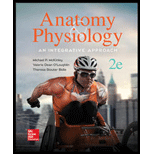
Anatomy & Physiology: An Integrative Approach
2nd Edition
ISBN: 9780078024283
Author: Michael McKinley Dr., Valerie O'Loughlin, Theresa Bidle
Publisher: McGraw-Hill Education
expand_more
expand_more
format_list_bulleted
Concept explainers
Question
Chapter 14, Problem 9DYKB
Summary Introduction
Introduction:
Stretch reflex is monosynaptic reflex and gets activated upon the stretching of the muscle fibers. The stimulus causes the contraction and relaxation of the muscles as analyzed by the sensory neurons that are intercoiled along the intrafusal muscle fibers. The signals from the sensory neurons in the spinal cord are intercepted by the alpha motor neurons present in the muscle fibers.
Expert Solution & Answer
Want to see the full answer?
Check out a sample textbook solution
Students have asked these similar questions
What is the difference between Uniporters, Symporters and Antiporters? Which of these are examples of active transport?
What are coupled transporters?
What are “domains” and how do they aid in protein function?
Chapter 14 Solutions
Anatomy & Physiology: An Integrative Approach
Ch. 14.1 - Prob. 1WDYLCh. 14.1 - Prob. 2WDYLCh. 14.2 - Prob. 3WDYLCh. 14.3 - Prob. 4WDYLCh. 14.3 - Prob. 5WDYLCh. 14.4 - Prob. 6WDYLCh. 14.4 - What are the general locations and functions of...Ch. 14.4 - What type of information does the posterior...Ch. 14.4 - Prob. 9WDYLCh. 14.4 - Prob. 10WDYL
Ch. 14.4 - Prob. 11WDYLCh. 14.5 - Prob. 12WDYLCh. 14.5 - Prob. 13WDYLCh. 14.5 - Prob. 14WDYLCh. 14.5 - Prob. 15WDYLCh. 14.5 - Prob. 16WDYLCh. 14.5 - Prob. 17WDYLCh. 14.5 - Which nerve might you have damaged if you have...Ch. 14.5 - Prob. 19WDYLCh. 14.5 - Prob. 20WDYLCh. 14.5 - Prob. 21WDYLCh. 14.6 - What are the four main properties of a reflex?Ch. 14.6 - Prob. 23WDYLCh. 14.6 - Prob. 24WDYLCh. 14.6 - Prob. 25WDYLCh. 14.6 - Identify the Golgi tendon reflex (which is an...Ch. 14.6 - Prob. 27WDYLCh. 14.7 - Prob. 28WDYLCh. 14 - Prob. 1DYKBCh. 14 - Prob. 2DYKBCh. 14 - Prob. 3DYKBCh. 14 - Prob. 4DYKBCh. 14 - Prob. 5DYKBCh. 14 - Prob. 6DYKBCh. 14 - Prob. 7DYKBCh. 14 - Prob. 8DYKBCh. 14 - Prob. 9DYKBCh. 14 - Prob. 10DYKBCh. 14 - Prob. 11DYKBCh. 14 - List the three gray matter horns on each side of...Ch. 14 - Compare the main differences between the posterior...Ch. 14 - Prob. 14DYKBCh. 14 - Prob. 15DYKBCh. 14 - Prob. 16DYKBCh. 14 - Prob. 17DYKBCh. 14 - Prob. 18DYKBCh. 14 - Prob. 19DYKBCh. 14 - Prob. 20DYKBCh. 14 - Prob. 1CALCh. 14 - Prob. 2CALCh. 14 - Prob. 3CALCh. 14 - Prob. 4CALCh. 14 - Prob. 5CALCh. 14 - Prob. 1CSLCh. 14 - Prob. 2CSLCh. 14 - Prob. 3CSL
Knowledge Booster
Learn more about
Need a deep-dive on the concept behind this application? Look no further. Learn more about this topic, biology and related others by exploring similar questions and additional content below.Similar questions
- What are intrinsically disordered proteins, and how might they be useful for a living system?arrow_forwardWhat are Amyloid Fibrils? What biological functions are these known to perform?arrow_forwardHow do histamine and prostaglandins help in the mobilization of leukocytes to an injury site? What are chemotactic factors? How do they affect inflammation process?arrow_forward
- Compare and contrast neutrophils and macrophages. Describe two ways they are different and two ways they are similar.arrow_forwardDescribe the effects of three cytokines (not involved in the initial inflammation response). What cells release them?arrow_forwardDescribe activation of helper T cells or cytotoxic T cellsarrow_forward
- Compare and contrast MHC 1 and MHC 2. Describe two way they are different and two ways they similar including how they are used in antigen presentation.arrow_forwardDescribe two antimicrobial properties of the skin.arrow_forwardDescribe how the inflammation response starts including the sentinel cells and the chemicals involved. How do pathogens trigger the response particularly in the skin?arrow_forward
- How does complement promote the immune response? Describe three waysarrow_forwardWhich of the following is not a possible mechanism for autoimmunity? Select one: A. Abnormal expression of MHC II molecules in non-antigen-presenting cells B. Activation of polyclonal B cells C. Polymorphism of HLA alleles D. Molecular mimicry E. Release of sequestered antigensarrow_forwardWRITTEN WORK 3: NON-MENDELIAN GENETICS Part A: Complete the Punnett square and calculate for the probability of genotype and phenotype. i i Genotype: Phenotype: 08:55arrow_forward
arrow_back_ios
SEE MORE QUESTIONS
arrow_forward_ios
Recommended textbooks for you
 Human Anatomy & Physiology (11th Edition)BiologyISBN:9780134580999Author:Elaine N. Marieb, Katja N. HoehnPublisher:PEARSON
Human Anatomy & Physiology (11th Edition)BiologyISBN:9780134580999Author:Elaine N. Marieb, Katja N. HoehnPublisher:PEARSON Biology 2eBiologyISBN:9781947172517Author:Matthew Douglas, Jung Choi, Mary Ann ClarkPublisher:OpenStax
Biology 2eBiologyISBN:9781947172517Author:Matthew Douglas, Jung Choi, Mary Ann ClarkPublisher:OpenStax Anatomy & PhysiologyBiologyISBN:9781259398629Author:McKinley, Michael P., O'loughlin, Valerie Dean, Bidle, Theresa StouterPublisher:Mcgraw Hill Education,
Anatomy & PhysiologyBiologyISBN:9781259398629Author:McKinley, Michael P., O'loughlin, Valerie Dean, Bidle, Theresa StouterPublisher:Mcgraw Hill Education, Molecular Biology of the Cell (Sixth Edition)BiologyISBN:9780815344322Author:Bruce Alberts, Alexander D. Johnson, Julian Lewis, David Morgan, Martin Raff, Keith Roberts, Peter WalterPublisher:W. W. Norton & Company
Molecular Biology of the Cell (Sixth Edition)BiologyISBN:9780815344322Author:Bruce Alberts, Alexander D. Johnson, Julian Lewis, David Morgan, Martin Raff, Keith Roberts, Peter WalterPublisher:W. W. Norton & Company Laboratory Manual For Human Anatomy & PhysiologyBiologyISBN:9781260159363Author:Martin, Terry R., Prentice-craver, CynthiaPublisher:McGraw-Hill Publishing Co.
Laboratory Manual For Human Anatomy & PhysiologyBiologyISBN:9781260159363Author:Martin, Terry R., Prentice-craver, CynthiaPublisher:McGraw-Hill Publishing Co. Inquiry Into Life (16th Edition)BiologyISBN:9781260231700Author:Sylvia S. Mader, Michael WindelspechtPublisher:McGraw Hill Education
Inquiry Into Life (16th Edition)BiologyISBN:9781260231700Author:Sylvia S. Mader, Michael WindelspechtPublisher:McGraw Hill Education

Human Anatomy & Physiology (11th Edition)
Biology
ISBN:9780134580999
Author:Elaine N. Marieb, Katja N. Hoehn
Publisher:PEARSON

Biology 2e
Biology
ISBN:9781947172517
Author:Matthew Douglas, Jung Choi, Mary Ann Clark
Publisher:OpenStax

Anatomy & Physiology
Biology
ISBN:9781259398629
Author:McKinley, Michael P., O'loughlin, Valerie Dean, Bidle, Theresa Stouter
Publisher:Mcgraw Hill Education,

Molecular Biology of the Cell (Sixth Edition)
Biology
ISBN:9780815344322
Author:Bruce Alberts, Alexander D. Johnson, Julian Lewis, David Morgan, Martin Raff, Keith Roberts, Peter Walter
Publisher:W. W. Norton & Company

Laboratory Manual For Human Anatomy & Physiology
Biology
ISBN:9781260159363
Author:Martin, Terry R., Prentice-craver, Cynthia
Publisher:McGraw-Hill Publishing Co.

Inquiry Into Life (16th Edition)
Biology
ISBN:9781260231700
Author:Sylvia S. Mader, Michael Windelspecht
Publisher:McGraw Hill Education
GCSE PE - ANTAGONISTIC MUSCLE ACTION - Anatomy and Physiology (Skeletal and Muscular System - 1.5); Author: igpe_complete;https://www.youtube.com/watch?v=6hm_9jQRoO4;License: Standard Youtube License